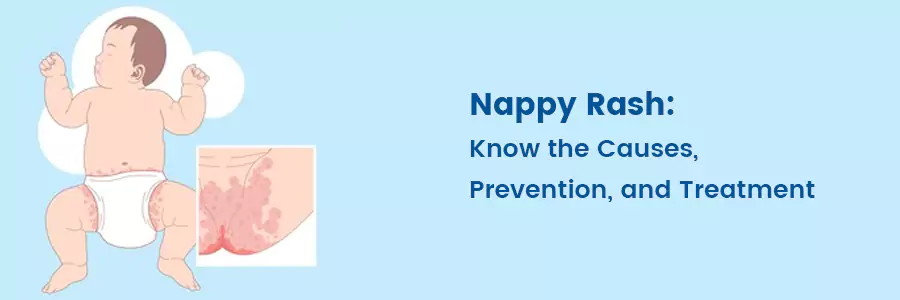Categories
- Cardiology 84
- Dermatology 45
- Endocrinology 33
- ENT 16
- Fertility 190
- Gastroenterology 78
- General-Medicine 81
- Gynecology 80
- Hematology 19
- Infectious-Diseases 33
- Neurology 52
- Oncology 34
- Ophthalmology 23
- Orthopedics 69
- Pediatrics 31
- Procedure 23
- Public-Health 144
- Pulmonology 59
- Radiology 8
- Urology 68
- Wellness 161
- Woman-and-child 77

How to Protect Your Baby From Nappy Rash?
At some age, most babies develop nappy rash. It is usually mild and does not bother your baby. In some cases, it can be severe and sore.
What is Nappy Rash?
Nappy rash, also known as diaper rash, is a common form of inflamed skin that appears as a patchwork of bright red skin on your baby's bottom. It typically occurs in infants and toddlers who wear diapers and can cause discomfort and fussiness.
What Causes Nappy Rash?
A nappy rash is a skin inflammation caused by a reaction to urine and poo. It is common in babies and can cause discomfort and irritation.
Candida Infection
- Candida Germs: Candida thrives on inflamed skin, causing an infection known as thrush.
- Appearance: The rash turns brighter or darker red due to Candida.
- Bacterial Infection: Other germs, like bacteria, can also infect the rash, making it redder and more painful.
Teething and Nappy Rash
- Increased Saliva: During teething, babies produce more saliva.
- Changes in Poo: This changes the nature of baby poo, making it more likely to cause a reaction when it contacts the skin.
- Worsening Rash: Nappy rash often worsens during teething.
Severity
- Mild to Moderate: Most nappy rashes are mild or moderate and not harmful.
- Unusual Rashes: Sometimes, nappy rash can be caused by other skin problems like eczema, psoriasis, infections, or uncommon skin illnesses.
Secure your health with a second opinion. Make informed decisions and book your appointment today!
Get A Second OpinionPrevention and Healing of Nappy Rash
1. Change Nappies Frequently
- Quick Changes: Change the nappy as soon as it's wet to keep the skin dry.
- Teething Care: If your baby is teething and has an offensive poo, change nappies more often.
2. Let the Skin Breathe
- Nappy-Free Time: Allow the baby to lie without a nappy as much as possible.
- Absorbent Sheets: Use a disposable towel or absorbent sheet under the baby and change it when wet.
3. Keep the Skin Dry
- Pat Dry: After washing, gently pat the baby's bottom dry before putting on a new nappy.
- Avoid Rubbing: Do not rub the skin with a towel.
4. Avoid Irritants
- No Talcum Powder: Avoid using talcum powder as it can irritate the skin.
- Skip Lotions and Soaps: Refrain from using lotions, bubble baths, and soaps.
5. Use Barrier Creams
- Protective Layer: Apply a thin layer of barrier cream or ointment before putting on a nappy.
- Breathability: Avoid applying too much cream to keep the nappy breathable.
6. Avoid Tight Plastic Pants
- Breathability: Tight-fitting plastic pants can trap moisture and worsen the rash.
Ready to take control of your health journey? Book your appointment now and start your path towards wellness today!
Book an AppointmentTreatment for Nappy Rash
- Mild Rash: For mild nappy rash, the mentioned preventive measures are usually enough to clear it.
- Worsening Rash: consult a pediatrician if the rash worsens, your pediatrician may recommend different ointments in addition to the preventive measures.
- Suspected Infection: If the rash continues to worsen despite ointment use, it may be infected with bacteria or Candida. Antibiotic or antifungal medications may be needed in this case.
Serious or Persistent Rash: Consult a pediatrician if a nappy rash can occasionally be unusual or more serious. If the rash does not improve with the above treatments, seek advice from your pediatrician.
Frequently Asked Questions
Nappy rash, commonly known as diaper rash, is a common skin irritation that infants develop around their diaper area.
Certain foods can make nappy rash worse if they cause acidic stools, like citrus fruits or tomatoes.
No, nappy rash is not contagious and cannot be passed from one baby to another.
Cloth diapers may help reduce nappy rash because they allow for better air circulation compared to disposable diapers.
Use gentle wipes or clean with warm water and a soft cloth to avoid irritating the rash further.
Teething can lead to more frequent stools, which may contribute to nappy rash. Keeping the diaper region clean and dry can help to avoid it.
If nappy rash persists despite home care, your doctor may recommend a medicated cream or ointment to treat any underlying yeast infection.

Categories
- Cardiology 84
- Dermatology 45
- Endocrinology 33
- ENT 16
- Fertility 190
- Gastroenterology 78
- General-Medicine 81
- General 6
- Gynecology 80
- Hematology 19
- Infectious-Diseases 33
- Neurology 52
- Oncology 34
- Ophthalmology 23
- Orthopedics 69
- Pediatrics 31
- Procedure 23
- Public-Health 144
- Pulmonology 59
- Radiology 8
- Urology 68
- Wellness 161
- Woman-and-child 77